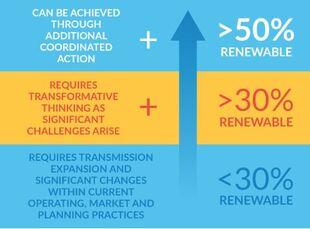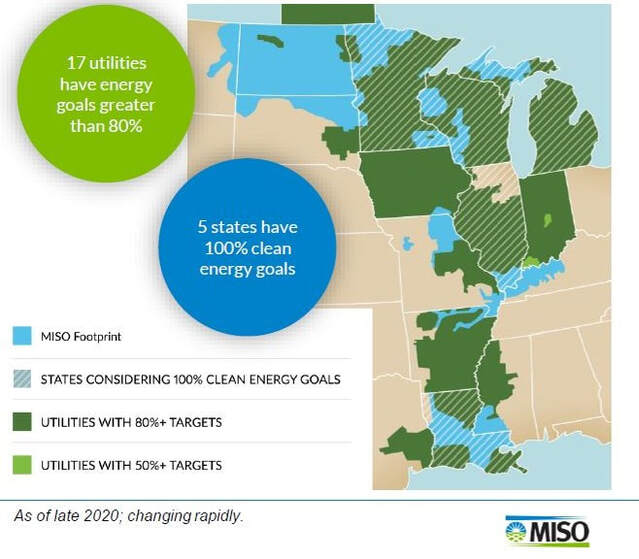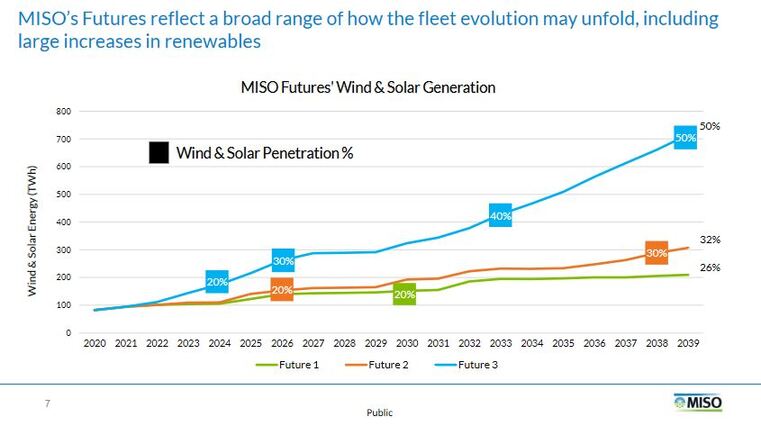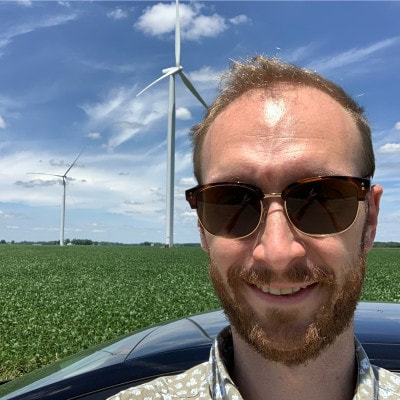Starting in 2017, the RIIA study has been an exhaustive effort in analyzing how the growth of renewables in MISO, and surrounding areas in the Eastern Interconnection could affect the reliability of their transmission system. In summary, MISO found that reaching 20-30% renewable energy throughout their 16 state footprint is challenging with their current grid infrastructure, but achievable. Above 50% throughout the footprint, will require a commitment to both integrating the right technology, and engaging in a robust collaborative planning effort for this future. Transitioning from fossil fuels to a grid that integrates a higher percentage of renewable energy requires a re-examination of how the grid works. With looming climate targets both from a scientific consensus, and a policy standpoint, the present moment is the best time for this to happen. But like most infrastructure, our electric transmission system has a limited lifespan, and transmission and distribution networks that were built decades ago are due for an investment of up to $900 billion dollars according to a Department of Energy Study released in 2015.
It’s clear that public policy is not the only driver of renewable growth within MISO, and in light of current winter storm induced power outages in mid February in the South, the grid simply must adapt to become more resilient to the negative impacts of climate change and ensure that power is available when it’s needed. With regards to the right technology, MISO indicates that as renewables increase throughout the footprint, there is a greater need for technologies like synchronous condensers which keep voltage levels stable on the transmission grid, as well as grid forming inverters, which can be utilized to restart the grid with renewable energy after a power outage. An additional finding from the RIIA report, was that a reliable and heavy renewable energy grid is not just about having more transmission, but having renewable energy projects distributed throughout a geographic area. When distributing renewable energy projects over a more diverse geographic footprint, the variability of renewable generation seems to decrease. Somewhat ironically, a diversity of siting within the MISO region seems to be absent between the northern and southern halves of the MISO footprint. Most notable, is the 10GW of solar modeled for the MISO South region that already equals the current signed Generator Interconnection Agreements (GIA) for the entire footprint. Conversely, wind is almost entirely absent in the south. All things considered, like the richness of solar resources in the south, and the complimentary richness of wind in the north, it seems that solar is being under-counted throughout the footprint in the RIIA analysis, while wind is over-counted in the north. As Simon Mahan of the Southern Renewable Energy Association tweeted, “Initially, RIIA looked at a 75/25 wind/solar split, heavily focused on MISO North where MISO North adds 95GW of renewables (mostly wind), but only 15 GW of solar in MISO South. Later, MISO also conducted a 50/50 solar/wind sensitivity. Things change, even in 4 yrs.” he further went on to say “(Aside: There’s already 12 GW of renewable energy projects in MISO’s Generation Interconnection Queue in the South, today. RIIA’s primary case shows roughly 12 GW utility-scale solar, and 3 GW of DG solar in MISO South. We’re going to blow past that. Fast.) ” The utility Xcel for one example stated in their Minnesota IRP that they may procure up to 4GW of solar by 2032. Additionally the North Indiana Public Service Company (NIPSCO) is pursuing a goal of 65% renewable energy by 2026, which include additions of 900MW of solar in the next 3 years. A key finding in the report indicates that energy storage can increase the Effective Load Carrying Capability (ELCC) for renewables of up to 30%. However, by the report’s own admission, it did not study energy storage at every penetration milestone considered, and did not focus on assessing what an optimal mode of operation for energy storage would be, or identifying the so-called ‘stacked benefits’ of energy storage. Considering that energy storage has been shown to provide a multitude of benefits, there could be untapped potential waiting to be modeled. There could also be implications in a higher renewable energy penetration scenario for MISO’s pending compliance on FERC Order 2222, which provides wholesale market access for distributed energy resource aggregators. The study does not delve deeply into distributed energy resources, or energy efficiency and demand response. Both of which could help to mitigate peak load by lowering demands on renewable energy resources. In many ways the largest challenge throughout MISO is engaging in the kind of collaborative and goal driven planning process that is required to meet a higher percentage of renewables throughout the footprint. The stakeholder process within MISO consists of a number of groups that may indicate different priorities and perspectives on either the need for decarbonization, the need for transmission infrastructure, or both. The energy transition is already underway, and the RIIA report is much more timely than it was in 2017 when the study first began and renewable goals were much more tepid amongst states, utilities and corporations in the footprint. Current MISO Futures indicate that 30% renewables throughout the region could happen as early as 2026 due to public policy and the sheer inertia of renewable energy projects being added to MISO's interconnection queue. Whether these projects get built or not, is a result of transmission planning to a degree as well, but the question remains - can the necessary planning for the transmission grid can be agreed upon by stakeholders in MISO and built to provide access to reliable renewable energy? How to foster engagement and alignment amongst stakeholders is a perennial question in public policy efforts around climate goals, but the scope of the RIIA study is truly remarkable, and a valuable first step in decarbonizing the energy system of the largest RTO in the country. * Corporate, utility and public policy goals vary in requirements, but are used throughout MISO as an indicator for how energy resources will change over time throughout the footprint. While public policy often carries the weight of enforcement or penalty for a lack of compliance to renewable and clean energy goals. About the Author
0 Comments
Leave a Reply. |
Archives
July 2024
Categories
All
|
|
|
If you want to be a frontline soldier on environmental protection, social justice, or environmental racism, come to Louisiana” –Gary Groesch, Founder of AAE
|
View our events calendar for important upcoming community events and public meetings!
|
|
Copyright © 2022 · Alliance for Affordable Energy






 RSS Feed
RSS Feed